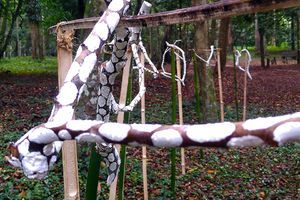On the way to Palmwag from Damara Mopane Lodge near Khorixas, I stopped in at the small settlement of Vrede. Vrede looks like any other settlement along the route, but its residents have a very interesting history.
The members of the twelve households that live in Vrede are all Riemvasmakers, their families having once lived in Riemvasmaak in the Northern Cape, South Africa.
I was fortunate to catch Maggie Vries at home on a day off from Etosha Heights Safarihoek Lodge, where she works as a manager. She explained how her parents, of Nama descent, moved to the country from South Africa in 1974. As the story is told, the people of Riemvasmaak were evicted by the South African government in 1973/1974 to make way for a South African military training site. Those of Xhosa origin were sent to the Transkei and those of Nama descent to Damaraland. The Nama settled in De Riet, Vrede, Bergsig, Khorixas and surrounds. Being small stock farmers, they adapted to their new environment, far from their ancestral home.
Maggie says that her parents moved from the farm Otihavera, near Palmwag, to De Riet, where she was born in 1975. They later moved to Vrede. She says, “I am Namibian by birth and a proud Riemvasmaker.”
She remembers the old people telling the stories of the time, and laughs as she recalls the expressive Afrikaans saying. “My grandmother didn’t want to move,” she says. “They told her, ‘Ouma, al kom die Here van die berg af, trek, sal jy trek (Grandmother, even if God comes from that mountain you will have to move from here)”.
After South Africa’s first democratic elections in 1994, the Riemvasmakers land was returned to the community and they were given the option of returning. “Eighty per cent went back and twenty per cent of us remained,” Maggie explains.
Her parents chose to remain in Namibia. The communities are still closely linked and visit family across the border for important family events.
Every year in October, a Riemvasmaker festival is held in De Riet. The graves of the elders are visited and the history is recounted. It is traditional to wear three colours: red, symbolising blood; white symbolising peace; and black, symbolising tears. At the festival they enjoy a traditional meal that includes roosterbrood and magou (a maizemeal drink). On the Sunday morning, the festival ends with a church service.
For Maggie, every day is a learning process to keep the culture alive. She says, “. . . because at the end of the day we are the leaders of tomorrow.”



.png?width=82&height=85&name=Navigate%20Namibia-03%20(1).png)
SUBMIT YOUR COMMENT